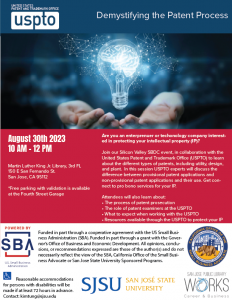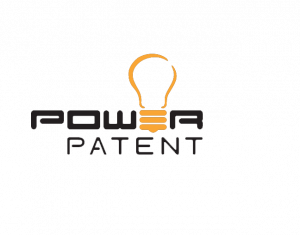PowerPatent presented at San Jose SBDC USPTO Seminar on Demystifying the Patent Process
— Silicon Valley SBDC
SAN JOSE, CA, US, August 31, 2023/EINPresswire.com/ — PowerPatent presents at San Jose SBDC USPTO Seminar on Demystifying the Patent Process
At the Silicon Valley SBDC event with the United States Patent and Trademark Office (USPTO), PowerPatent presented its generative AI drafting assistance software. At the event, USPTO experts discussed the difference between provisional patent applications and non-provisional patent applications and their use. Get connected to pro bono services for intellectual property. Brent Fairbanks is a Primary Patent Examiner at the United States Patent and Trademark Office (USPTO) with a focus on data processing of sensor measurements. He serves as an Assistant Outreach Coordinator for the Western Regional Office, supporting programs for inventors, entrepreneurs, and other communities in the western United States along with K-12 STEM activities.
PowerPatent in turn showed founders and entrepreneurs its patent drafting software and cost saving strategies to build a valuable IP portfolio. Presenter patent Attorney Bao Tran has over 20 years of experience in patent filing, prosecution, licensing and monetization. He has architected patent portfolios for many startups that went public such as Align Technologies and Shutterfly. Patent Attorney Tran discussed how tech businesses can use Intellectual Assets as a Competitive Advantage.
Intellectual assets serve as a powerful competitive advantage for businesses in today’s cutthroat market. Patents, trademarks, copyrights, and trade secrets provide a shield of exclusivity, safeguarding a company’s unique innovations, brand identity, and confidential information. This protection not only deters competitors from capitalizing on the company’s creations but also enables businesses to command premium pricing, secure customer loyalty, and explore lucrative licensing and partnership opportunities.
By leveraging their intellectual assets, companies can gain a distinct edge in the market, positioning themselves as pioneers in their respective industries and attracting potential investors who recognize the value of a well-protected and innovative portfolio. As innovation continues to drive success, harnessing intellectual assets has become an indispensable component of a winning business strategy that propels companies to the forefront of their markets. Intellectual property protection can achieve this in several ways:
1. Market Exclusivity
Patents and trademarks grant companies exclusive rights to their innovations and branding elements, respectively. This exclusivity prevents competitors from imitating or capitalizing on the company’s unique offerings, which can lead to increased market share and customer loyalty.
Market exclusivity, achieved through the protection of intellectual assets, is a compelling advantage that gives businesses a distinctive edge in the competitive landscape. Patents, trademarks, and copyrights provide legal barriers that prevent others from infringing upon a company’s innovative products, services, or branding elements. This exclusivity creates a unique selling proposition for the company, setting it apart from competitors and allowing it to carve out a niche in the market.
By securing a patent for a novel invention or process, a company gains a monopoly over its creation, giving it the sole right to manufacture, use, and sell the patented product. This exclusivity not only shields the company from direct competition but also establishes it as an industry leader, attracting customers seeking cutting-edge solutions. As the only provider of the patented product or service, the company can command premium pricing, leading to increased profitability and a stronger bottom line.
Trademarks, on the other hand, safeguard a company’s brand identity, logos, and slogans, ensuring that consumers associate them exclusively with the company’s offerings. A strong trademark creates brand recognition and fosters customer loyalty, which is vital in a crowded market where consumers are bombarded with choices.
Copyright protection is crucial for businesses involved in creative industries such as software, music, literature, and art. By securing copyrights, companies prevent unauthorized reproduction and distribution of their original works, maintaining control over their content and revenue streams.
Market exclusivity afforded by intellectual assets not only enhances a company’s market position but also serves as an attractive proposition for investors and potential partners. Investors are more likely to back companies with a unique and protected product or service, as it reduces the risk of imitation and increases the company’s potential for long-term success. Additionally, intellectual property protection can open doors to collaborations and licensing agreements, as other businesses may seek to leverage the protected innovations for mutual benefit.
Revenue generation through intellectual assets is a key benefit that significantly impacts a company’s financial performance and sustainability. By protecting their innovative ideas and creative works, businesses can tap into diverse streams of income, driving growth and profitability.
Patents play a crucial role in revenue generation by providing companies with the option to license their patented technologies to others. Through licensing agreements, businesses can grant other entities the right to use their patented inventions in exchange for licensing fees and royalties. This not only serves as a passive income stream but also expands the reach of the technology to markets and industries beyond the company’s immediate capabilities.
Furthermore, patents can serve as bargaining chips in negotiations and cross-licensing deals with other companies. Such arrangements allow businesses to access valuable technologies held by others, fostering innovation and driving collaboration within the industry.
Copyrights enable businesses in creative fields to monetize their works in various ways. Software companies, for example, can offer their products through subscription models or one-time purchases, generating recurring revenue. Content creators, such as musicians, authors, or filmmakers, can sell their works directly to consumers or through distribution channels, generating income from sales, licensing, or streaming royalties.
Trademarks, too, contribute to revenue generation. A strong brand, reinforced by trademark protection, can attract a loyal customer base and facilitate premium pricing. Consumers are often willing to pay a premium for products or services associated with a trusted and recognizable brand, leading to increased sales and higher profit margins.
Moreover, market exclusivity resulting from intellectual asset protection can lead to a first-mover advantage, allowing a company to dominate the market before competitors can develop alternative solutions. This early market dominance can lead to significant revenue gains and solidify the company’s position as a market leader.
By leveraging their intellectual assets, companies can gain a distinct edge in the market, positioning themselves as pioneers in their respective industries
3. Investor Attraction
Investor attraction is significantly bolstered by the presence of well-protected intellectual assets within a company’s portfolio. Investors are constantly seeking opportunities that promise high returns and low risks, and intellectual property protection offers precisely that.
Intellectual assets, such as patents and trademarks, demonstrate a company’s commitment to innovation and its ability to differentiate itself from competitors. A robust portfolio of protected patents signifies that the company has unique and valuable technologies that can disrupt the market or offer significant improvements over existing solutions. This appeals to investors who recognize the potential for substantial growth and market dominance.
Moreover, intellectual property protection serves as a barrier to entry for potential competitors, reducing the risk of imitation and market saturation. This reduction in competitive pressure provides investors with greater confidence in the company’s ability to maintain its market position and secure sustainable revenue streams.
Investors are also attracted to the revenue-generating potential of intellectual assets. Patents, for instance, can lead to licensing opportunities, allowing the company to generate additional income through licensing fees and royalties. Copyrights enable businesses to monetize their creative works and software through various distribution models, creating multiple revenue streams.
Furthermore, intellectual property protection enhances a company’s bargaining power in negotiations and partnerships. Companies with strong intellectual assets become attractive targets for strategic investors or potential acquirers seeking to gain a competitive edge in the market or expand their product/service offerings.
From an investor’s perspective, intellectual assets are tangible indicators of a company’s intangible value. A robust portfolio demonstrates the company’s vision, foresight, and commitment to long-term success. Investors are more likely to support companies that are proactive in protecting their innovations, as this showcases a keen understanding of the importance of intellectual property in sustaining a competitive advantage.
4. Brand Value
Intellectual assets contribute significantly to a company’s brand value, serving as a foundation for building a strong and recognizable brand identity. Trademarks, copyrights, and even patents play a vital role in shaping how a company is perceived by consumers and stakeholders alike.
Trademarks are powerful assets that help establish a company’s brand identity in the market. They represent the company’s reputation, quality, and values. A well-protected trademark becomes synonymous with the company’s products or services, making it easier for consumers to identify and trust the brand. As brand recognition grows, the company can capitalize on customer loyalty, fostering repeat business and word-of-mouth referrals.
Moreover, trademarks offer protection against unauthorized use of the brand, safeguarding it from dilution or damage caused by counterfeit products or inferior imitations. This protection ensures that the company’s reputation remains intact, maintaining consumer trust and confidence.
Copyrights also contribute to brand value, especially for companies in creative industries. Original and copyrighted works, whether they are music, literature, software, or artistic creations, add a unique element to the brand’s identity. Consumers often associate the company’s creativity and innovation with its copyrighted content, strengthening the brand’s appeal.
In addition to trademarks and copyrights, patents can also enhance brand value. Patented technologies and inventions not only differentiate the company’s products but also convey a sense of innovation and technological prowess. This perception of being at the forefront of advancements in the industry can elevate the company’s brand value and attract consumers who seek cutting-edge solutions.
From an investor’s perspective, a strong brand adds intangible value to the company, making it a more attractive investment opportunity. A company with a well-established and protected brand is better positioned to withstand market fluctuations and competition. The brand’s reputation can create a loyal customer base, ensuring a stable revenue stream and reducing the investment’s overall risk.
5. Collaboration and Partnerships
Intellectual property assets play a pivotal role in facilitating collaborations and partnerships between companies. Businesses with protected intellectual assets become attractive partners for other organizations seeking to leverage their innovations or enhance their offerings.
Firstly, companies with strong intellectual property portfolios are perceived as more reliable and credible partners. Intellectual property protection demonstrates a commitment to protecting valuable assets, which instills confidence in potential collaborators that their innovations will also be respected and safeguarded.
Secondly, intellectual property assets can serve as bargaining chips in negotiations for collaborations. Companies with unique patented technologies or copyrighted content can offer access to these assets as part of a partnership agreement, opening doors to mutual benefits. Such collaborations can lead to the development of innovative products or services that combine the strengths of both partners, creating new revenue streams and market opportunities.
Additionally, intellectual property rights can define the scope and terms of a collaboration. Companies can negotiate licensing arrangements, allowing one party to use the other’s intellectual assets in exchange for fees or royalties. These agreements provide a structured framework for cooperation and ensure that the parties’ rights and interests are respected throughout the partnership.
In some cases, collaborations may involve cross-licensing of intellectual assets. Companies with complementary patent portfolios can exchange licenses to use each other’s technologies, fostering innovation and mutual growth. This exchange not only expands each company’s technological capabilities but also fosters a spirit of cooperation and trust.
Intellectual Assets and Funding Appeal
When seeking funding from investors, venture capitalists, or even government grants, presenting a compelling case is crucial. Intellectual property protection enhances a company’s funding appeal in several ways:
1. Demonstrating Vision and Commitment
Obtaining and maintaining intellectual property rights requires time, effort, and financial investment. A company that has secured patents, trademarks, or copyrights demonstrates its commitment to protecting its innovations and brand identity. This signals to investors that the company is forward-thinking, has a long-term vision, and takes its competitive advantage seriously.
2. Reducing Risks for Investors
Investing in startups and new ventures inherently involves risk. By protecting intellectual assets, a company mitigates some of the risks associated with competitors copying or infringing on its ideas. This can provide a level of assurance to investors that their investments are safeguarded and that the company’s innovations have a higher chance of market success.
3. Attracting Strategic Investors
Strategic investors often seek opportunities that align with their own interests and core competencies. Intellectual assets can be a magnet for such investors, especially when they complement or enhance the investor’s existing portfolio. By offering a unique and protected technology or product, a company becomes an attractive target for strategic partnerships or acquisitions.
4. Valuation and Negotiation Power
A company with a robust intellectual property portfolio can command a higher valuation. Intellectual assets contribute to the company’s overall worth and future revenue potential. This, in turn, gives the company stronger negotiation power when discussing funding terms with investors or potential buyers.
5. Signaling Market Readiness
Investors often seek to fund companies that are ready to enter the market or have a clear path to commercialization. Intellectual property protection can signify that the company has reached a certain level of maturity and readiness for market entry. This can instill confidence in investors that their funds will be put to good use.
In today’s competitive business landscape, protecting intellectual assets is no longer a luxury; it is a necessity for companies seeking to thrive and secure funding. Patents, trademarks, copyrights, and trade secrets provide a significant competitive advantage by offering market exclusivity, revenue generation opportunities, and enhanced brand value.
From the perspective of investors, intellectual property protection demonstrates a company’s vision, commitment, and ability to reduce risks, making it an attractive investment opportunity. It also provides leverage during negotiations and opens the door to strategic partnerships.
Mary Kimani
PowerPatent
+1 800-234-3032
email us here
Visit us on social media:
Facebook
Twitter
LinkedIn
Instagram
YouTube
TikTok
How PowerPatent AI Assisted Patent Workflow Software works
![]()
Originally published at https://www.einpresswire.com/article/653152272/powerpatent-presents-at-san-jose-sbdc-uspto-seminar-on-demystifying-the-patent-process
The post PowerPatent presents at San Jose SBDC USPTO Seminar on Demystifying the Patent Process first appeared on Beauty Ring Magazine.
Beauty - Beauty Ring Magazine originally published at Beauty - Beauty Ring Magazine








